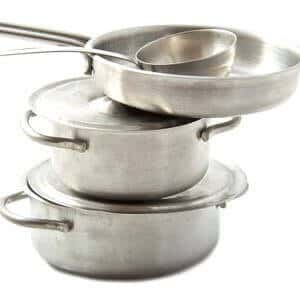
Q. After reading your information about aluminum in antiperspirants I changed to using milk of magnesia as a deodorant. I’m very pleased with it.
Now I am starting to wonder whether my cookware poses a similar danger with aluminum. It is a well-known brand and says on the bottom “aluminum clad stainless steel.”
A. We doubt that your cookware poses a problem if the aluminum is on the outside. Manufacturers sometimes use aluminum on the bottom of pots and pans to enhance heat transfer.
If the interior of the frying pan or pot is stainless steel, you should have nothing to worry about. On the other hand, there can be some absorption of aluminum from pans made of this metal and used to cook acidic or salty foods (Food Additives and Contaminants, Oct. 1996).
French researchers came up with a fascinating way to reduce the amount of aluminum that leaches out of cookware and into food (Food and Chemical Toxicology, March 2009). Here is what they discovered:
“Aluminium has been used extensively in foodstuffs, utensils and packaging. Depending on the meal, the cooking in aluminium cookware can expose humans to the ingestion of important quantities of aluminium. In our human body, aluminium ion can inhibit different metabolism processes by competition reactions with other ions such as iron, magnesium, calcium, phosphor, fluoride and others. Aluminium (Al) is associated with anaemia, osteomalacia [weakened bones], and a neurologic syndrome known as dialysis encephalopathy. Then, both in experimental animals and in human, aluminium is clearly identified as a potent neurotoxicant…
THEIR CONCLUSION:
“We studied the corrosion of alimentary aluminium foils by an aqueous solution of citric acid, simulating the conditions of cooking acidic ingredients as tomato sauce, lemon juice…
“Our results indicate that for reducing the leachability of aluminium from aluminium cookware into foods and per consequence, also to decrease the daily aluminium intake during the preparation of food, we must boil water in aluminium kitchen utensils (such as pots, pans, and coffee percolators and others) used for cooking the food. Per consequence, the daily aluminium intake will decrease.
“The pre-treatment of aluminium utensils for a certain time is very important to protect the public health.
“In conclusion, we recommend a change in foods and beverages cooking practices. This could also apply to storage materials.”
“The authors showed that boiling the cookware in water prior to cooking is suitable for the decrease of aluminium leaching into food by a factor up to sixty (with a corresponding decrease of the aluminium intake by consumers).”
Most people may not want to boil aluminum foil or cookware before using it. As a result, we would suggest that non-aluminum cookware is a convenient solution. We would suggest not using aluminum foil to barbecue meat that has been marinated with lemon juice or other acidic liquids.
WHAT ABOUT ANTIPERSPIRANTS?
We are delighted that you found MoM (milk of magnesia) an effective deodorant. Aluminum-based antiperspirants remain controversial. There is a surprising paucity of data regarding aluminum absorption from long-term use of products containing salts such as aluminum chlorohydrate.
There is one report in the medical literature (American Journal of Medicine, Dec. 2004) of a woman who began applying an aluminum chlorohydrate-containing antiperspirant every morning at age 39. “Her underarms, which were shaved regularly, did not have any rash or skin irritation. After experiencing bone pain and extreme fatigue without other obvious explanation, she was evaluated in detail.”
The researchers discovered that this woman had excessive levels of aluminum in her body (hyperaluminemia) that might have accounted for her symptoms.
“Use of the antiperspirant was discontinued in our patient, and 1 to 3 months later aluminum levels in plasma and urine had decreased markedly. By 8 months after discontinuation of the antiperspirant, the aluminum overload disappeared completely and her symptoms resolved concurrently.”
These French investigators concluded:
“Circumstantial evidence indicates that severe hyperaluminemia resulted from repeated applications of an aluminum-containing antiperspirant during a considerable period of time (4 years). The disappearance of bone pain in the patient a few months after antiperspirant use was stopped, as well as the pronounced decrease in plasma and urine aluminum concentrations to normal levels, strongly suggest that the toxicity observed was due to aluminum chlorohydrate, the active ingredient in the antiperspirant. Although individual variations in aluminum absorption are likely, the risk of increased aluminum uptake suggests that caution should be exercised when using aluminum-containing antiperspirants frequently.”
A more recent study of aluminum absorption from antiperspirants (Journal of Inorganic Biochemistry, May, 2012) concluded
“The use of Al [aluminum] salt-based antiperspirant remains widespread all over the world and more particularly in the USA (> 90% of the population). In addition to large-scale transcutaneous Al penetration and suspected neuro-degenerative pathologies, a number of authors have mentioned a possible connection between increased antiperspirant use and heightened incidence of breast and prostate cancer. Given these observations, the French Ministry of Health has been applying the precautionary principle by discussing with manufacturers about how to end use of this metal in antiperspirants.”
We hope that researchers will resolve this controversy sooner rather than later, given that tens of millions of people use such antiperspirant products every day. But the FDA has not distinguished itself when it comes to requiring such studies. Unlike the French Ministry of Health the U.S. regulators rarely employ the “precautionary principle.” Until we have firm answers to these important questions, we think milk of magnesia offers a reasonable option for controlling underarm odor. It is a deodorant and not an antiperspirant.
Here is a link to learn more and here is a link to purchase MoM. And if you would like to try our brand new Women’s MoM Aluminum Free Roll-On Deodorant, click here.

